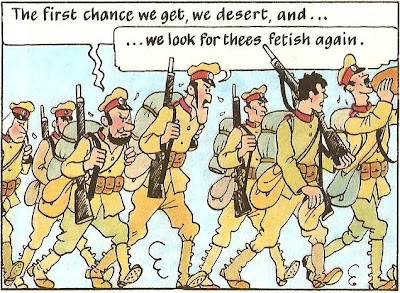The truth is that I don’t blame Hergé (whose real name was George Remi) at all. His Tintin books – which I read when I was young – were so well written, researched, and illustrated that I found them inspiring.
My two favourite Tintin books are THE BROKEN EAR and KING OTTOKAR’S SCEPTRE. The former is set in San Theodoros, a small South American country that is ruled by a dictator (General Alcazar), and which is on the verge of war with its neighbour – Nuevo Rico – over possible oil deposits in the border area called the Gran Chapo (sounds familiar, doesn’t it?). The latter is set in Syldavia, a small Balkan country ruled by a king (King Muskar XII), and which is on the verge of war with its neighbour – Borduria – who had conquered Syldavia in the twelfth century and ruled it until it revolted and regained its independence after 1277.
Research has shown that many of the illustrations in Hergé’s books – including those in THE BROKEN EAR – were based on contemporary photographs, and as a result the stories seem to have added authenticity. Hergé also uses characters and organisations that can be recognised even if they are not mentioned by their real names but are given names that are similar or parodies thereof.
Examples of this include Mr Tickler of ‘General American Oil’ (there was an oil company called ‘General American Oil Company of Texas’ that was founded in 1936!), …
 … Bazil Bazarov of ‘Korrupt Arms GMBH’ (this is obviously a double reference to Sir Basil Zaharoff, a director and chief salesman of ‘Vickers Armstrong’, and the ‘Krupp’ armaments firm), …
… Bazil Bazarov of ‘Korrupt Arms GMBH’ (this is obviously a double reference to Sir Basil Zaharoff, a director and chief salesman of ‘Vickers Armstrong’, and the ‘Krupp’ armaments firm), …
 … who sells General Alcazar six dozen 75 TRGP Field Guns (incidentally, this was one of the Field Guns used by the Belgian Army at the time; it is worth noting that Hergé’s brother was a Belgian Army officer), …
… who sells General Alcazar six dozen 75 TRGP Field Guns (incidentally, this was one of the Field Guns used by the Belgian Army at the time; it is worth noting that Hergé’s brother was a Belgian Army officer), …
 ... and an unnamed representative of ‘British South-American Petrol’ (a slightly veiled reference to British Petroleum, which began life as the ‘Anglo-Persian Oil Company’).
... and an unnamed representative of ‘British South-American Petrol’ (a slightly veiled reference to British Petroleum, which began life as the ‘Anglo-Persian Oil Company’).
 The uniforms worn by the San Theodoran army are also worth a second look; they bear some resemblance to those worn by the Bolivian Army during the 1930s.
The uniforms worn by the San Theodoran army are also worth a second look; they bear some resemblance to those worn by the Bolivian Army during the 1930s.

My two favourite Tintin books are THE BROKEN EAR and KING OTTOKAR’S SCEPTRE. The former is set in San Theodoros, a small South American country that is ruled by a dictator (General Alcazar), and which is on the verge of war with its neighbour – Nuevo Rico – over possible oil deposits in the border area called the Gran Chapo (sounds familiar, doesn’t it?). The latter is set in Syldavia, a small Balkan country ruled by a king (King Muskar XII), and which is on the verge of war with its neighbour – Borduria – who had conquered Syldavia in the twelfth century and ruled it until it revolted and regained its independence after 1277.
Research has shown that many of the illustrations in Hergé’s books – including those in THE BROKEN EAR – were based on contemporary photographs, and as a result the stories seem to have added authenticity. Hergé also uses characters and organisations that can be recognised even if they are not mentioned by their real names but are given names that are similar or parodies thereof.
Examples of this include Mr Tickler of ‘General American Oil’ (there was an oil company called ‘General American Oil Company of Texas’ that was founded in 1936!), …
 … Bazil Bazarov of ‘Korrupt Arms GMBH’ (this is obviously a double reference to Sir Basil Zaharoff, a director and chief salesman of ‘Vickers Armstrong’, and the ‘Krupp’ armaments firm), …
… Bazil Bazarov of ‘Korrupt Arms GMBH’ (this is obviously a double reference to Sir Basil Zaharoff, a director and chief salesman of ‘Vickers Armstrong’, and the ‘Krupp’ armaments firm), … … who sells General Alcazar six dozen 75 TRGP Field Guns (incidentally, this was one of the Field Guns used by the Belgian Army at the time; it is worth noting that Hergé’s brother was a Belgian Army officer), …
… who sells General Alcazar six dozen 75 TRGP Field Guns (incidentally, this was one of the Field Guns used by the Belgian Army at the time; it is worth noting that Hergé’s brother was a Belgian Army officer), … ... and an unnamed representative of ‘British South-American Petrol’ (a slightly veiled reference to British Petroleum, which began life as the ‘Anglo-Persian Oil Company’).
... and an unnamed representative of ‘British South-American Petrol’ (a slightly veiled reference to British Petroleum, which began life as the ‘Anglo-Persian Oil Company’). The uniforms worn by the San Theodoran army are also worth a second look; they bear some resemblance to those worn by the Bolivian Army during the 1930s.
The uniforms worn by the San Theodoran army are also worth a second look; they bear some resemblance to those worn by the Bolivian Army during the 1930s.




























No comments:
Post a Comment
Thank you for leaving a comment. Please note that any comments that are spam or contain phishing messages or that come from Google Accounts that are 'Unknown' will be deleted.